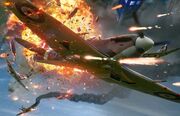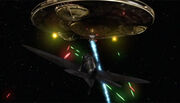A Supermarine Spitfire was a type of aeroplane used by the British during the Second World War.
History[]
As a result of time breaks caused by Elliot Payne's experiments, a Spitfire and a German Messerschmitt were transported roughly fifty years back in time and appeared in the sky over London in the 1890s, where they continued their fight. This was witnessed by Henry Gordon Jago, a native of that era, and Leela. One of the planes was severely damaged and its pilot parachuted out of the plane. Jago, having never seen either a "flying machine" or a parachute, suggested to Leela that he should hire the pilot to perform his "act" at the New Regency Theatre. (AUDIO: Chronoclasm)
The Spitfires, as part of the Royal Air Force were used heavily during the London Blitz, when they were regularly engaged in protecting Britain from Luftwaffe attacks. (TV: The Empty Child/The Doctor Dances, PROSE: Exodus)

British Spitfire taking heavy fire during in the Battle of Britain. (AUDIO: Their Finest Hour)
The most notable example of the Spitfire's usage was during the Battle of Britain, a battle for air dominance over the English Channel, in 1940. (AUDIO: Their Finest Hour, PROSE: /Carpenter/Butterfly/Baronet, Timewyrm: Exodus) Despite many casualties, (AUDIO: Their Finest Hour) the Spitfires, in conjunction with the Hurricanes, repelled the attack, effectively ending the Nazi Blitzkrieg campaign. (PROSE: /Carpenter/Butterfly/Baronet) Following the battle, the Spitfire became Britain's most decorated and historically admired aircraft even though the Hurricanes destroyed more Luftwaffe aircraft in 1940 than all the other British aircraft types combined. (PROSE: The Shadow in the Glass)
On the R101 in October 1930, the Eighth Doctor noted that if a Triskele energy weapon was brought back to Britain it would result in the production of Spitfires armed with laser cannons that could easily win the Battle of Britain, warning that the course of history could be changed. (AUDIO: Storm Warning)

A Spitfire fighting against a Dalek Saucer. (TV: Victory of the Daleks)
Winston Churchill sent three modified Spitfires (Danny Boy, Jubilee, and Flintlock) into space to fight a Dalek ship threatening the planet below. The Spitfires were outfitted for space with a gravity bubble and were armed with laser weapons, which were based on technology created by Dr Edwin Bracewell. Their mission was to destroy a beacon on the Dalek ship which illuminated London at night, leaving it vulnerable to German attack. Two Spitfires were destroyed, but the last one, "Danny Boy", succeeded. After he had completed his primary mission, the Eleventh Doctor ordered him to destroy the Dalek ship. However, the Doctor countermanded these orders when the Daleks threatened to destroy the Earth. "Danny Boy" then returned to Earth. (TV: Victory of the Daleks)
Though this advanced technology was to be dismantled to avoid altering history, it was used again when the Doctor summoned "Danny Boy" to Demon's Run, where he destroyed the facility's communications array, then returned to his own time. (TV: A Good Man Goes to War)
In 1948, Spitfires were deployed during the Arab-Israeli conflict. One downed Spitfire was unearthed in 1972 by Ezekiel Child. The Third Doctor tried to stop the archaeological effort, believing the Spitfire was a source of temporal disruption. However, it turned out the Spitfire was harmless and the disruption stemmed from Child himself. (PROSE: The Suns of Caresh)
Retired Wing Commander Alec Whistler, who had been a Spitfire pilot during the Second World War, brought out every summer for the village fete at Culverton a Spitfire which he had restored himself, and was in full working order. It would play a key part in the defeat of the Master and the Gaderene. (PROSE: Last of the Gaderene)
Marcus Americanius Scriptor wrote of Spitfires, as well as other British and German aircraft, while exploring the Known Worlds of Germania. (PROSE: Warlords of Utopia)
Behind the scenes[]
- The Spitfires in Victory of the Daleks and A Good Man Goes to War were presumably the Mk IXs due to the number of propeller blades and the air intakes under the wings are the same shape. Mk IX Spitfires were the first to have twin air intakes under the wings. Previous Mks had different intakes.
- The bulletproof engines used in Spitfires were designed by Bill Dunn, the father of Sheila Dunn.
